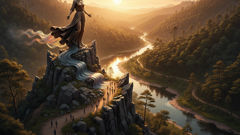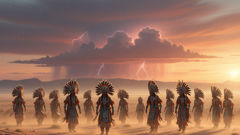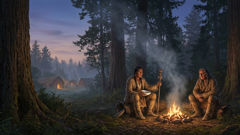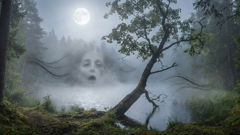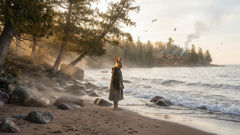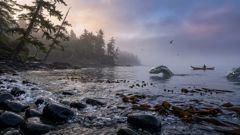Introduction
Along the ragged edge of Norway where fjords cut like blades into stone, and the Atlantic breathes cold on every rib of coastline, the sea kept its own stories. For generations, coastal people—fiskere, skjærgårdsfolk, and old sailors whose skin had been pocked by spray and sun—spoke in low voices about shapes that rose from depth and shadow. These tales were not idle entertainment: they were memory, warning, and weather report wrapped in metaphor. The word kraken traveled in that speech, a hush-name for a thing that hid below the swell and sometimes, in the dead calm between storms, revealed itself. In older Norse vocabularies other monstrous names shared the stage. The hafgufa, described in some medieval accounts as an island-sized maw that lured seafarers and belched out such spray that men thought it a shore; the lyngbakr, another leviathan likened to a great whale with the deceptive habit of appearing like a grassy rock—each variant belonged to a map of danger. If scholars later traced parts of the saga to real animals—giant squid, great whales, tumbling kelp forests—the original stories were not simple misreadings. They were how people made sense of an ocean whose motions often exceeded explanation.
For the coastal communities of western Norway, the Kraken and its kin were more than a monster on a chart: they were an element of life. Songs and lullabies carried the image of tentacles like gnarled trees, of ships swallowed whole and of sudden whirlpools that yawned where none had been before. The narratives changed with each telling; fishermen embellished with the particularities of their catches, priests and landowners judged the tales as superstition, and skippers used them as shorthand for places to avoid in fog or during certain tides. Yet the image persisted: a dark circumference at sea, a thing that could be mistaken for an island until ropes or an axe revealed flesh instead of rock. Even centuries before naturalists tried to reconcile myth with biology, the Kraken occupied a complex place between human imagination, empirical observation, and seafaring practice. This study gathers those threads: medieval mentions, oral recollections, regional versions across Norway and Greenland, and the ways valid seamanship and modern science reframed the terror and wonder of a myth that still fishes for our attention.
Origins and Earliest Accounts: From Konungs skuggsjá to Coastal Memory
The first threads of what would become Kraken lore appear in practical manuals and monastic writings as well as in the gossip of fishing hamlets. Norse texts and medieval clerical guides sometimes catalogued strange sea-forms alongside weather signs and navigational counsel. These records were not uniform—one scribe might record a caution against a 'sea that rises like an island and then sinks,' while another described 'a mouth so vast it snatches both fish and men.' In part, this variation reflects regional speech: words moved and shifted through communities where storytelling served a pragmatic purpose. A coastal farmer might hear a skiff-barefooted boy call something a 'krake' and later a merchant would note in his ledger that a skiff had found itself near an 'island' that, upon approach, rolled and sank. The practical and the poetic braided together.
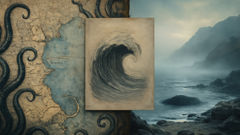
The medieval Norse lexicon offers names that often overlap with what we call the Kraken today. Lyngbakr, literally 'heather-back,' appears in sagas as a creature so massive that when it settled near shore, it looked like a patch of land covered with vegetation. The hafgufa—roughly 'sea reek' or 'sea mist' in some renderings—was imagined as a great breathing throat in the ocean. Seaworthy men swapped stories about the hafgufa’s appetite: it lay in wait, exuding a stench and a false horizon of spray, and anything that settled on it might never return. These names were applied imprecisely and often interchangeably in oral retellings. A captain might call a particular hazard a lyngbakr in one season and the same spot a kraken the next; sailors used what words best fit the given danger. What mattered at sea was the consequence—whirlpools where anchors went slack, sudden downpours of oily water; and the communal memory of men who did not return.
There is an enduring practicality in the way sailors described sea monsters: the Kraken became, in many local narratives, shorthand for particular combinations of conditions. Large kelp beds could appear as dark ridges on the surface, and eddies between tidal flows could draw men toward concealed rocks that took the hull. Swells wrapped black, turning a shoal into a dip that swallowed light. On certain nights, bioluminescent shoals glowed, and in windless weather, the reflection of stars and moon on calm water might be mistaken for phosphorescent creatures. The oral tradition required metaphor; calling such hazards a kraken communicated urgency and danger more effectively than a dry geographic note. Over centuries, those metaphors layered into more elaborate accounts. A fisherman who had seen a giant squid fighting a whale would embellish the retelling to the point where tentacles became trees and the whale became an island pulsing with breath. That is how myth and observation coexisted: one translating the other for survival.
The cartographers of the early modern period—who relied on reports from mariners—sometimes drew monstrous figures on maps to signify uncertain or dangerous waters. These images reinforced the identification of certain coasts with beastly cruelty. Yet even marginal annotations on a map reveal a human attempt to catalogue unknowns. If deep channels off the Bergen coast were marked with a tentacled beast, it was not only to frighten readers but to label a cluster of experiences: hard-to-chart shallows, unpredictable tides, and sudden squalls that had cost ships. In this sense, the Kraken was less a single entity than a conceptual tool used by communities to apprehend the sea’s caprices.
Linguistic history offers small keys to understanding the myth. The root words that fed into kraken suggested something twisted or contorted—an image consistent with long, curling limbs and a back that buckled like driftwood. In coastal speak, names traveled: a Danish fisherman could relate a story picked up in a Norwegian harbor, and the tale would change. Icelandic variations preserved their own lexical flavors; the Greenlandic and Shetlandic transcripts—shaped by Norse settlement and contact—introduced additional idioms. When ethnographers later gathered such material, they decoded overlapping names and recognized that one phenomenon, experienced by multiple observers, could be framed by different words in different places. The result was a mosaic rather than a single portrait. Yet when the accounts converged—when multiple, independent witnesses described the same kind of island-that-wasn’t-an-island or tentacle that wrapped around a hull—scholars and sailors had to admit there was an observable pattern behind the myth.
Scientific explorers and naturalists in later centuries sought to translate the Kraken into taxonomy. Reports of giant tentacles and massive suckers were often linked to cephalopods—giant squids of the Architeuthis genus—and to the occasional, colossal squid that could reach extraordinary size. Still, not every Kraken account maps neatly onto a single species. Some versions—particularly those that describe whole ships being dragged below by sweeping moorings—better fit scenarios combining kelp entanglements, currents, and the simple misperception of a landform at sea. That said, the discovery of very large squids in the deep Atlantic and elsewhere gave tangible flesh to the older stories. When sailors hauled up a fragment of a beak or discovered scars on whales, the link between myth and biology grew firmer. Yet the cultural life of the Kraken remained separate: even after scientific explanations circulated, people continued to tell stories that refused to be shrunken by empirical categories. The Kraken, in a meaningful sense, belonged equally to the realm of human fear and to the catalogues of natural history.
Understanding the Kraken therefore requires moving between registers—between pragmatic seamanship and a narrative imagination that made the sea legible in human terms. In medieval and early modern Norway, the beast functioned as a system of knowledge. It warned, taught, and gave shape to events that could otherwise appear arbitrary. It embodied coastal anxieties—about hunger, navigation, and the unpredictability of weather—while also giving the sea a personality that people could address. If a captain cursed the Kraken when a sudden tide took his anchor, he was invoking a lineage of speech that explained loss in collectively recognized terms. Those terms survived because they were useful, expressive, and repeatable. As we read back through sagas and listening to the residue of songs and proverbs, we can recover how an entire seafaring culture used myth to live under and with the ocean’s authority.
Regional Variations, Cultural Uses, and the Kraken in Everyday Life
As the Kraken story circulated across the north Atlantic—finding voice in Norway, Iceland, the Faroe Islands, and Greenland—it adapted to local ecologies and livelihoods. In each place the beast’s features shifted to match common hazards and the things people knew best. On the Lofoten banks and the Vestlandet coast, where cod and herring runs made seasonal fortunes, the Kraken might be invoked in a cautionary note: don’t anchor in that dark swell at dawn or your net will vanish. In more remote fjord-mouths, where whales occasionally stranded and kelp forests tangled lines, the description leaned toward the lyngbakr image—an island disguised by vegetation. In Greenlandic adaptations, contact between Norse settlers and indigenous peoples reshaped motifs; elements of the Kraken integrated with local sea-spirits and practical knowledge about ice, currents, and seal routes.
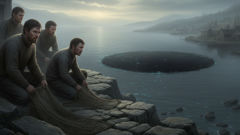
These regional variants were not merely fanciful. They organized behavior. For example, certain coves acquired reputations and specific taboos. Fishermen might avoid setting nets at night in a named inlet because previous generations had reported watching a swelling rise and then an entire team’s raft failing to return. The naming of these places—often with archaic words—functioned as cartography built out of memory instead of survey. Mothers’ lullabies that warned children to obey were sometimes threaded with Kraken images: a child who wandered beyond the rocks invites the krake’s fingers. Such usage shows how myth became disciplinary and protective, a cultural technology that bolstered survival.
Story formats also varied: the short cautionary tale, the embellished night-long narrative told at a table where ale loosened tongues, the terse log entry of a captain who would not otherwise be inclined to superstition. Where fishermen’s songs survive, they often compress the Kraken into a single striking image—a tentacle across a hull, a spray that reeks like iron. In longer sagas, the creature takes on more personality. One northern tale records an episode in which a skiff approaches what looks, at first, like a low island. Men shout and throw stones until the 'island' belches a cloud and a great maw is glimpsed. That kind of episodic tale emphasizes the deceitful quality of the creature and the need for vigilance. Elsewhere, a similar episode will focus on rescue or luck: a young seaman who ties his belt to the mast survives when the craft is half-submerged. The moral contours differ according to regional values—courage in some tellings, prudence and the heed of elders in others.
Material culture carried Kraken imagery as well. Net-floats, rudimentary amulets, and carved figureheads sometimes bore monstrous motifs. A carved prow in a small boat might carry a grotesque face intended to frighten away whatever unnatural thing lay beneath—an inversion of the creature’s power through a protective symbol. In other contexts, priests or local religious leaders interpreted the Kraken as a test or a demonic temptation: sailors who bragged of catching sea-giants, so went the sermon, were being prideful in the face of God’s creation. Such readings exist alongside more secular ones and show how myth could be integrated into theological frameworks without losing its indigenous, practical function.
When commercial whaling developed and oceanic navigation improved, encounters that once fed myth changed. Deckhands who hauled large whales and witnessed scars consistent with battles against giant cephalopods introduced new narratives that seemed to confirm older tales. The physical evidence—sucked lenses of light, riven flesh, the rare beak recovered from a whale’s stomach—made the Kraken story anatomically credible. Yet even in the face of such proof, old metaphors persisted, because the myth had social utility beyond description. It mediated how communities explained luck, loss, and the caprice of nature.
The interplay between modern science and the folklore took interesting turns in the nineteenth and early twentieth centuries, when naturalists cataloged deep-ocean fauna and seamen returned with specimens and stories. Newspapers picked up sensational tales, sometimes embellishing them to sell papers; literary artists, too, appropriated the image for dramatic effect. Still, on the ground in coastal villages, daily practice did not change because of headlines. Fishermen who had always been taught to read currents, cloud-forms, and the behavior of birds kept doing so. They used Kraken-talk as shorthand for a cluster of signs: a long swell without weather, a patch of ink-black water, the sudden absence of gulls, and a hush that fell over the surface. Seafaring knowledge, therefore, used the creature not as an alternative to observation but as its complement.
In a cultural sense, the Kraken became a repository for the emotional weight of the sea. Loss was common in seafaring communities: children lost fathers, wives lost husbands, and entire crews sometimes vanished. The Kraken offered a named, storied place where such grief could be located. A widow might say that the sea took her man to a kraken, a phrase that held both literal and symbolic meaning—literal in that a storm or a current took a vessel, and symbolic in that the loss was integrated into communal memory through narrative. That is why the Kraken remains legible as both horror and consolation: it frames danger and anchors recollection. The same image that warns a man to distrust a calm morning also gives words to someone who will never see a husband return. Folklore thus functions as language for absence and ways to pass practical knowledge between generations.
Another layer of the Kraken story involves performance. In coastal festivals and seasonal gatherings, people re-enacted tales with masks and crude tentacles fashioned from driftwood and kelp. These practices were not merely theatrical; they were pedagogical forms that embedded seasonal warnings into enjoyable forms. Children learned geography through story—where not to fish, which inlet to avoid after a southerly gale—because the tales were contagious and memorable. Story became curriculum. Over time, as modern navigation and technology altered daily risk, these performative practices dwindled, but vestiges of them survive in local museums and in the continuing fascination of writers and artists who return to the theme for its deep symbolic resonance.
Finally, the Kraken’s evolution across regions shows how myth is adaptive. As Norway’s coasts were re-mapped and new scientific vocabularies spread, local accounts did not die out; they metamorphosed. Some communities attended meetings where naturalists explained giant cephalopods; others kept telling older versions. The myth’s durability rests on its ability to absorb new data and repurpose it into stories that are still useful—wise, instructive, or consoling. The Kraken remains a living element of cultural memory, an emblem of the sea’s capacity both to provide and to take away.
Conclusion
The Kraken, in the coastal imagination of Norway and its neighboring islands, was never only a monster on the loose. From medieval counsel-books to the songs mothers hummed while mending nets, the image functioned as a cultural tool—an embodied caution that carried practical knowledge about tides, kelp, and deceptive horizons. When naturalists later described enormous squids and sailors recovered signs of deep-sea struggle, science provided a vocabulary that sharpened the old picture without fully erasing it. Myth and observation continued, side by side. That duality explains the Kraken’s endurance: it binds humans to an ocean that is both known and unknowable, a body whose movements must be respected even when they can be partially predicted. In Norway’s coastal villages the legend taught prudence, offered consolation, and allowed communities to speak of absence; in maps and margins, it warned navigators; in songs and carvings, it preserved memory. Today the Kraken continues to appear—in museums, literature, and the popular imagination—as both a relic of earlier epistemologies and a symbol of our ongoing fascination with the deep. The creature’s long shadow over maritime culture reminds us that people have always used stories to make the world livable. We name what scares us, chart its edges, and hand the narrative on, because to name the unknown is a way of living with it.


